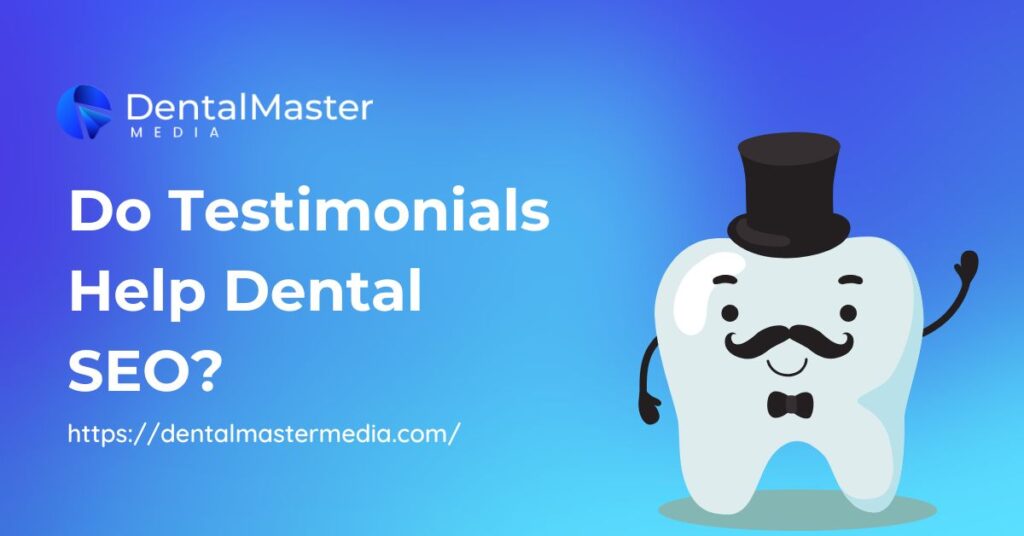A parent searching late at night lands on your service page. A simple quote,“gentle, explained every step, my child actually smiled”,gives them the confidence to book.
Testimonials reduce doubt and strengthen search signals: fresh content, real experiences, and visible trust.
The short answer is yes,clear, well-placed testimonials lift clicks, keep visitors engaged, and build credibility.
The longer answer is about doing it right: add them where decisions happen, mark them up for search engines, and always collect them respectfully.
How Testimonials Improve Search Signals
They lift click-through rate (CTR)
When a searcher sees reassuring language or review indicators near your listing, curiosity turns into clicks. Higher CTR, coupled with fewer quick bounces, tells search engines the page fits the query.
That positive loop begins with a credible snippet and continues when the on-page experience matches the promise.
Working with Specialized Dental SEO Experts helps clinics craft these signals consistently, building trust and visibility at every stage of the search journey.
They increase time on page and reduce quick exits
A concise quote or a short thank-you video invites people to pause. That pause becomes a scroll, a tap on your booking button, or a read of your FAQs.
Longer visits and deeper interactions are healthy user signals and a practical sign that testimonials are doing real work for the reader.
They add freshness and topical relevance
New comments add recent, human language to your pages. Patients naturally use the phrases people search,simple words about comfort, clarity, timing, and outcomes.
That living language keeps pages relevant and makes them feel current when someone compares options.
They reinforce E-E-A-T in plain English
Experience, expertise, authority, and trust can sound abstract. In practice, they mean a visitor can tell real people vouch for your care.
Named testimonials with light context,first name and initial, service type, and timing,convey credibility quickly.
A brief internal link beside a quote that leads to a fuller “Patient Stories” page helps readers who want more detail, and you can link back from that page to related services to keep navigation smooth.
Where Testimonials Work Best on Your Website
Home page
Place a small, fast-loading row of quotes in the middle of the page. Keep each to two or three lines, add a first name and initial, and reference the service.
The goal is to reassure without crowding the main message, then guide people to book with a nearby button.
Service pages
Add one or two service-specific quotes near the first decision point. On an implants page, a sentence about comfort during surgery and eating well again helps.
On a hygiene page, a line about gentle care and clear tips after the appointment is enough. Pair each quote with a text link to a longer story for readers who want depth.
Location pages
Use testimonials that mention practical details patients ask about, such as parking, access, or a friendly reception experience. This lowers friction and reduces back-and-forth questions, which often translates into quicker bookings.
Blog posts and FAQs
If a post explains how often children should see a dentist, include a parent’s comment about a calm first visit.
It humanises the answer and nudges the reader toward your booking pathway without interrupting the article.
Don’t Forget Off-Site Reviews (and the Map Pack)
Google Business Profile
Ask for reviews consistently and reply with warmth and specifics. Thank people for their time, acknowledge what they mentioned, and address concerns without defensiveness. Recent reviews often influence who gets the call when two clinics appear side by side.
Other platforms
If you show up on health or local directories, keep your details consistent. A few current reviews on secondary platforms act like cross-checks for both readers and algorithms. Consistency across places strengthens trust.
Bring off-site proof on-site,carefully
Embedded widgets can be heavy. If performance drops, switch to static quotes and a light text link that points readers to your profile for more.
Preserve speed first; a fast page showcases your care better than a flashy slider that stalls.
On-Site Best Practices That Search Engines (and Patients) Appreciate
Use real names and helpful context
With clear consent, include a first name and initial, plus a short service tag. Context makes quotes feel genuine and helps readers decide faster.
If someone prefers anonymity, initials still work when the language is specific. add Best SEO services for Dentist

Add faces or short video where possible
A small headshot or a 15–30 second clip builds trust quickly. Keep files compressed and captions available. The aim is to put a human voice to the words without slowing the page.
Mark up reviews with simple structured data
Use straightforward Review or AggregateRating schema on relevant pages. Accuracy matters more than ambition.
Mark up what is actually on the page and avoid inflating ratings. Clean markup helps search engines understand your content and may enable richer results.
Keep speed and accessibility strong
Compress images, lazy-load any carousels, and maintain high colour contrast for quote text. Make controls reachable by keyboard, add sensible aria-labels, and keep font sizes readable. Inclusive design helps every visitor and avoids signals that frustrate users.
Ethical Ways to Ask for Testimonials
Ask at the right moment
Right after a positive visit is the best time. A warm thank-you at reception or a short follow-up message the next day, with a direct path to leave feedback, keeps momentum while the memory is fresh.
Make it effortless
Offer a few prompt ideas so people know what to write about. Encourage honesty, not scripts. Helpful prompts focus on comfort, clarity of explanation, and outcomes that mattered in daily life.
Respect local rules
Follow advertising standards. Do not offer incentives that break guidelines, and do not ask for specific phrases. Invite honest feedback and be ready to accept a polite decline without pressure.
Examples and Mini Case Studies
Example 1 : Service page tune-up
A clinic added two short quotes to its emergency page, moved one above the fold, and placed a booking button just below.
Visitors saw immediate proof and acted faster. Calls rose because the page answered the emotional question first: “Will you help me quickly and clearly?”
Example 2 : Location page that actually helps
A practice used three concise testimonials on a location page. Two mentioned easy access and convenient hours.
Common questions dropped, and more visitors went straight to booking because practical worries had already been addressed.
Example 3 : Video plus transcript for accessibility
A 25-second thank-you video, paired with a transcript, kept the page fast and understandable even with sound off.
The text added relevant phrases, and the clip provided a human connection that a paragraph alone could not.
What to Measure (So You Know It’s Working)
Engagement and behaviour
Track scroll depth and time on page before and after adding testimonials. Watch taps on the primary booking button near quotes. Look for stable improvements rather than sharp spikes.
Local and conversion signals
Monitor profile calls, direction requests, and review volume month by month. In your search data, watch CTR on pages with review markup and note any growth in queries that include words like “reviews” or “best.” Confirm that completed bookings and tracked calls rise in tandem with these signals.
Writing and Editing Better Testimonials
Keep them short and specific
Two or three sentences are plenty. A clear before-and-after story beats a long paragraph. Natural, everyday language is what helps undecided readers take the next step.
Cover the big concerns
People care about comfort, clarity on steps and fees, timing that fits real life, and outcomes that improve daily routines. A sentence or two on these points builds confidence without sounding coached.
Match testimonials to the page topic
Place aligner quotes on aligner pages, hygiene comments on hygiene pages, and child-focused remarks where parents are likely to land. Relevance is what turns reassurance into action.
Common Mistakes to Avoid
Using anonymous or generic quotes
“Great service!” does not persuade. Add at least initials and a service tag, and keep the language concrete so it sounds like a real person.
Overloading pages with heavy widgets
A slow slider is a conversion tax. If performance suffers, switch to static cards with a manual next button and keep the page quick.
Over-optimising with awkward keywords
Do not stuff location terms or exact-match phrases into patient voices. Let people speak naturally. Authenticity converts better and avoids spammy signals.
Letting reviews go stale
A steady trickle is better than a one-time push. Even a couple of new notes each month keeps pages feeling alive and current.
Copy-pasting the same quotes everywhere
Duplicate quotes make pages blend together. Rotate them and focus on the specific decision a visitor is trying to make on each page.
A Simple 14-Day Action Plan
Days 1–3 , Gather and prepare
Collect recent reviews with consent. Trim for length without changing meaning. Select two or three for each key service page and a handful for your home page. Keep a separate list ready for location pages and FAQs.
Days 4–7 , Implement cleanly
Add testimonial blocks near the first booking button. Compress any headshots. Add clear, accurate schema where appropriate. Check accessibility for contrast, font size, and keyboard navigation.
Days 8–10 , Improve your ask
Create a short SMS or email template with a direct path to leave feedback. Train your front-desk team to ask at natural moments, such as after a thanks at checkout. Add a simple “Share your experience” line to confirmations and receipts.
Days 11–14 , Measure and iterate
Compare CTR, scroll depth, and bookings to your baseline. Replace any vague or underperforming quotes. Set a recurring reminder to request a few reviews each month so freshness remains steady.
Frequently Asked Practical Questions
Should I use star ratings on my site?
If you genuinely collect star ratings and have permission to display them, modest indicators can help.
Keep the display honest. A mix of high but believable ratings looks more trustworthy than a perfect wall of fives.
Can I edit testimonials?
Editing for clarity and typos is fine; altering meaning is not. Remove anything that could reveal private health details unless explicit consent covers it, and keep the patient’s voice intact.
How many testimonials do I need?
Quality beats volume. Two precise, recent quotes that match the page topic will outperform a long, generic testimonial page with no clear next step.
Do videos make a big difference?
Short, sincere clips help readers feel they know you. Keep them under half a minute, add captions, compress the file, and include a text summary for speed and accessibility.
Final Checks Before You Publish
Read each quote aloud. If it sounds like a marketing copy, it is probably too polished. Confirm consent and how the person wants to be identified.
Keep performance strong by favouring simple cards over heavy sliders, and place a useful internal link near each quote so a reader can move forward without hunting.
Conclusion
Testimonials work because they help people decide calmly and quickly. They also bolster the signals that shape search visibility: better click-through, deeper engagement, and clearer proof of trust.
Place short, specific quotes where decisions happen, renew them regularly so pages stay fresh, and mark them up cleanly so machines and humans can understand them.
If you’d like a friendly second pair of eyes on review flow, on-page placement, and measurement, the team at Dental Master Media can help you set up a light, reliable system your whole team can run with confidence.

Suraj Rana is the owner of Dental Master Media and a leading expert in SEO for dental practices. With a passion for dental marketing, he has successfully helped numerous dental clinics climb the search engine ranks. Suraj’s expertise makes him a go-to resource for effective, results-driven dental marketing.

